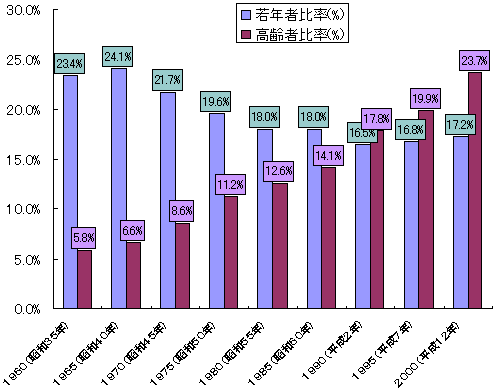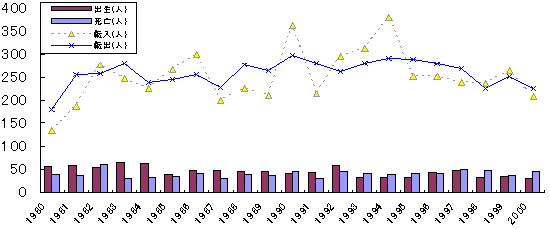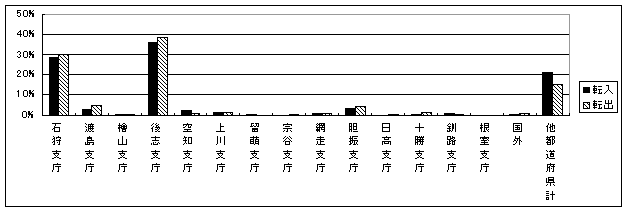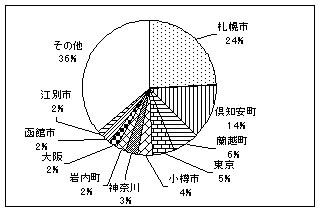3 Current Situation and Problems of Niseko Town 3: 4
3-4 Demographics of Niseko Town
1. Current situation of population / household
Comparing the trend of the population since 1980 with the population of the census every 5 years, the number of people increased by 26 in the 5 years from 1976 to 1960, the rate of increase was 0.6%, but since 1985 In the 5 years until 1992, 82 people decreased slightly, 1.8%. From 1990 to 1995, 130 people started to increase by 2.9%, but in 2000 the number was 4,553 people, 1.9% decrease, which is almost flat from 1980 to the present I will.
Table 1 Trends in Population Census Population
| Classification | 1960 (Showa 35) year | 1965 (Year of Showa) | Year 1970 | Year 1975 | 1980 (Showa 55) year | |||||
| Real number | Real number | Rate of change | Real number | Rate of change | Real number | Rate of change | Real number | Rate of change | ||
| Total number | 7,838 | 7,086 | -9.6% | 5,725 | -19.2% | 5003 | -12.6% | 4,587 | -8.7% | |
| 0 - 14 years old | 2,827 | 2,142 | -24.2% | 1,500 | -30.0% | 1,136 | -24.3% | 928 | -18.3% | |
| 15 to 64 years old | 4,560 | 4,478 | -1.8% | 3,732 | -16.7% | 3,309 | -11.3% | 3,062 | -7.5% | |
| 15 to 29 years old (a) | 1,837 | 1,708 | -7.0% | 1,242 | -27.3% | 980 | -21.1% | 822 | -16.1% | |
| 65 years and over (b) | 451 | 466 | 3.3% | 493 | 5.8% | 558 | 13.2% | 577 | 3.4% | |
| Young people ratio (a) / Total number | 23.4% | 24.1% | - | 21.7% | - | 19.6% | - | 18.0% | - | |
| Elderly population ratio (b) / Total number | 5.8% | 6.6% | - | 8.6% | - | 11.2% | - | 12.6% | - | |
| Classification | 1985 (Year of Showa) | 1990 (Heisei 2) | 1995 (Heisei 7) | 2000 (Heisei 12) year | ||||||
| Real number | Rate of change | Real number | Rate of change | Real number | Rate of change | Real number | Rate of change | |||
| Total number | 4,593 | 0.6% | 4,511 | -1.8% | 4,641 | 2.9% | 4,553 | -1.9% | ||
| 0 - 14 years old | 889 | -4.2% | 794 | -10.7% | 769 | -3.1% | 657 | -14.6% | ||
| 15 to 64 years old | 3,058 | -0.1% | 2,912 | -4.8% | 2,950 | 1.3% | 2,815 | -4.6% | ||
| 15 to 29 years old (a) | 827 | 0.6% | 745 | -9.9% | 780 | 4.7% | 756 | -3.1% | ||
| 65 years and over (b) | 646 | 12.0% | 805 | 24.6% | 922 | 14.5% | 1,081 | 17.2% | ||
| Young people ratio (a) / Total number | 18.0% | - | 16.5% | - | 16.8% | - | 16.6% | - | ||
| Elderly population ratio (b) / Total number | 14.1% | - | 17.8% | - | 19.9% | - | 23.7% | - | ||
Trend of the population (basic resident registry)
| Classification | March 31, 1995 | March 31, 2000 | |||
| Real number (people) | Component ratio (%) | Real number (people) | Component ratio (%) | Rate of change(%) | |
| Total number | 4,642 | - | 4,539 | - | -2.2 |
| Man | 2,235 | 48.1 | 2,204 | 48.6 | -1.4 |
| woman | 2,407 | 51.9 | 2,335 | 51.4 | -3. |
The population decline at Niseko Town is due to nationwide common factors such as population outflow to cities due to the rapid economic growth from the late 1960s, delays in the development of industrial and social infrastructure, and real estate agents. Due to the soaring land prices caused by land occupation of land, the progress has been made mainly on leaving farmers of pioneer settlers. However, in addition to the changes in the socio-economic situation today, the attraction of companies and the development of tourism have progressed, and the outflow of the population has been halted to a certain extent. Looking at the changes in the population since 1980, the population has remained flat I am.
The number of households increased by 26.4% from 1,397 households in Showa 55, 1,529 households in 1985, 1,583 households in 1990, 1,744 households in 1995, 1,766 households in 1995, 1,766 households in 2000, 20 years, and in contrast, the number of households per household Has declined to 3.3 in 1980, 3.0 in 1985, 2.8 in 1990, 2.7 in 1995, 2.6 in 2000, and the tendency toward nuclearization has been increasing.
The number of households increased by 26.4% from 1,397 households in Showa 55, 1,529 households in 1985, 1,583 households in 1990, 1,744 households in 1995, 1,766 households in 1995, 1,766 households in 2000, 20 years, and in contrast, the number of households per household Has declined to 3.3 in 1980, 3.0 in 1985, 2.8 in 1990, 2.7 in 1995, 2.6 in 2000, and the tendency toward nuclearization has been increasing.
Graph 1 Changes in the percentage of young people and the proportion of elderly people seen in the census

Looking at the table above, while the younger population ratio (population ratio from 15 to 29 years of age) shows a gradual declining trend, the elderly population ratio (the proportion of people over 65 years old) It shows that it is rapidly increasing.
Chart 2 Trend of Population Movement

2. Positioning of in / out rates in Niseko Town in towns and villages in Hokkaido (comparison with other towns and villages)
In 2000, the transference rate in Niseko Town(population with respect to the end of March 2001) was 4.6%, and the transference rate was 5.0%. The transference rate and transference rate were lower than in Hokkaido as a whole, and higher than the Shimo branch office.
Looking at the trends in the out-migration and in-migration rates in the past 10 years, the out-migration and in-migration rates in Niseko Town tend to be higher than the figures for Hokkaido as a whole, but higher than those of the Shimo branch office. In some years, the transfer rate is higher than the total road value including the city area.
Looking at the trends in the out-migration and in-migration rates in the past 10 years, the out-migration and in-migration rates in Niseko Town tend to be higher than the figures for Hokkaido as a whole, but higher than those of the Shimo branch office. In some years, the transfer rate is higher than the total road value including the city area.
Graph 3 Transition rate change

Source: Basic Resident Register
Graph 4 Transition rate

Source: Basic Resident Register
3.Trends and current status of moving in and out of Niseko Town
3-1 Changes in population dynamics over the past 20 years
The transition of transference and transference in Niseko Town has been increasing and decreasing between 200 and 400 people since 1982, and during the period from 1990 to 1994, there were many times when both transference and transference were large. However, since then, both in-migration and out-migration have been decreasing.
Assuming that the total number of migrants and the number of migrants in the past 20 years both exceeded the current population and the total number of years residing in all the townspeople was the same number of years, it is calculated that everyone will be replaced every 20 years.
The social dynamics shows a society decrease when the economy is in a booming period and a trend toward a society increase in which the changeover person exceeds the changeover place during the depression period.
Assuming that the total number of migrants and the number of migrants in the past 20 years both exceeded the current population and the total number of years residing in all the townspeople was the same number of years, it is calculated that everyone will be replaced every 20 years.
The social dynamics shows a society decrease when the economy is in a booming period and a trend toward a society increase in which the changeover person exceeds the changeover place during the depression period.
Graph 5 Changes in the number of people moving in and out of Niseko Town

3-2 Transfer, etc. by branch office etc. in the past 5 years etc.
In the past five years since 1996, the number of transfers and transfers to and from Niseko Town has largely been under the jurisdiction of the Shimo branch, accounting for nearly 40% (36% and 38%, respectively) of the total. Next, it is under the jurisdiction of the Ishikari Branch Office, accounting for about 30% (28% and 30%, respectively) of the whole.
In other areas, other prefectures are predominant, with 21% of in-migration and 15% of out-migration. Outbound transfers from Niseko Town surpassed inbound transfers for Ishikari and Shishi-chos and other provinces, and outbound transfers to Niseko Town for other prefectures. More.
In other areas, other prefectures are predominant, with 21% of in-migration and 15% of out-migration. Outbound transfers from Niseko Town surpassed inbound transfers for Ishikari and Shishi-chos and other provinces, and outbound transfers to Niseko Town for other prefectures. More.
Graph 6 Branch Office Transfer, etc. from 1996 to 2000

3-3 Trend of transferring and moving out
The largest number of destinations for Niseko Town for the five years from 1996 to 2000 is Sapporo City. Next, it is Kutchan-cho under the jurisdiction of the Shishi branch office, followed by Rankoshi-cho for relocation and Otaru-shi for relocation.
There are also many transfers to and out of the road, especially social movements with major metropolitan areas such as Tokyo, Kanagawa, Osaka etc.
For Sapporo City, Kutchan Town, Otaru City, there are more migrations than transferring, but from Ranetsu Town and the metropolitan area outside the street there are more transfers than moving out.
There are also many transfers to and out of the road, especially social movements with major metropolitan areas such as Tokyo, Kanagawa, Osaka etc.
For Sapporo City, Kutchan Town, Otaru City, there are more migrations than transferring, but from Ranetsu Town and the metropolitan area outside the street there are more transfers than moving out.
Graph 7 Area to transfer to Niseko Town

Graph 8: Destination area from Niseko Town

Inquiries
- Niseko Town Hall
- TEL:0136-44-2121
- FAX:0136-44-3500